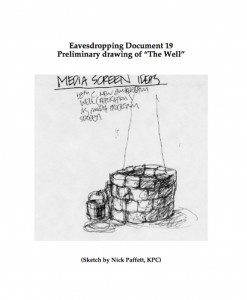Projects in the print-digital pipeline
01 April 2014 – Cathy Stanton

Sketch for a key element of the “Slavery in New York” exhibit, found in the Public History Commons collection relating to the exhibit.
Regular visitors to the Public History Commons may have noticed that we’ve undergone a slight facelift recently. The History@Work blog, initially the sole occupant of this site, has gradually been joined by other projects: the News Feed, The Public Historian’s digital space, and now our new Library. To try to keep our interface clear and easy to navigate, we’ve bumped the blog down a little bit on the page and simplified the navigation bar. We hope readers are finding their way around without too much trouble.
We’re also excited to introduce the Library to you. Although still in its very early stages, it represents an important step in a larger project of creating flexible platforms for publication and communication and ways for our print and digital projects to cross-pollinate more easily. We’re starting to get a sense of the possibilities through two recent collaborations, one of which revolves around Richard Rabinowitz’s award-winning article “Eavesdropping at the Well: Interpretive Media in the ‘Slavery in New York’ Exhibition.”Rabinowitz submitted the article to The Public Historian with a query about the potential to incorporate a number of supporting documents and illustrations—more than a print journal can generally include. A central intention of the article was to make the processes of exhibit creation more visible and to argue for a kind of critical reflection that takes into account the myriad aesthetic, intellectual, methodological, and institutional factors that go into mounting a history exhibit. In this case, the supporting documents were far more than just illustration. They provided windows into the kinds of constraints and choices that Rabinowitz parses in his essay.

Richard Rabinowitz’s “Eavesdropping at the Well” appears in the August 2013 issue of The Public Historian. His article won the 2014 G. Wesley Johnson Award for the best article in the journal from the previous volume year.
And so the “Eavesdropping at the Well” materials have become one of the first collections within the new Public History Commons Library. You’ll find planning and design documents, a few archival materials, and photographs that illuminate the processes Rabinowitz writes about. We’re seeing this as a model for future dossiers of material relating to specific exhibits, which can combine with critically reflective pieces in the print journal, online, or both.
Housing some of these pieces in the Commons lets more voices join the conversation, and we’ll work to create points of entry—like blog posts—where readers can add their thoughts. We see this as an important step toward deepening and expanding the sites and types of peer review within public history, as well as a way to foreground the many kinds of “gray literature” being produced around the field. (For a discussion of these ideas from 2013, see these notes from a THATCamp 2013 session.) This “gray lit” is often innovative and rigorously reviewed at many levels, but it seldom attracts the same level of critical attention or acclamatory recognition as higher-status forms like the academic monograph. Making a place for it is a way to acknowledge its crucial role in the production of public historical knowledge and thinking critically about it helps us to reflect on the kinds of processes that Richard Rabinowitz challenges us to recognize.
The conversation about “Eavesdropping at the Well” goes on with the latest issue of The Public Historian, which includes two new commentaries by Steven Lubar and Leslie M. Harris. Lubar’s essay notes that Rabinowitz’s approach to exhibits requires us to think multidimensionally, in time, space, sense, and movement. “[F]ew of us have the range of skills needed to pull [this] off,” Lubar admits, but he adds that it is a goal we can still strive for collectively, if not on an individual level.
In some ways this mirrors the task we’re undertaking here in the Public History Commons: making links on multiple levels with materials that are themselves dynamic and often disjunctive. The “Eavesdropping” project has let us experiment with some basic infrastructure for this. A second recent experiment has been the “Public History in a Changing Climate” collection, developed from materials in the Library (notably the collections of Working Group case statements from past Annual Meetings). That collection has begun to circulate through the list of conference-goers at this year’s meeting in Monterey and will be more widely available in conjunction with a special issue of The Public Historian in Summer 2014, focusing on public history and environmental sustainability. Ways to use this print-digital pipeline are becoming clearer to us as we continue to build and talk and collect, and we invite suggestions from people in the field about future projects and collaborations.
~ Cathy Stanton is Senior Lecturer in Anthropology at Tufts University and Digital Media Editor for the National Council on Public History.



